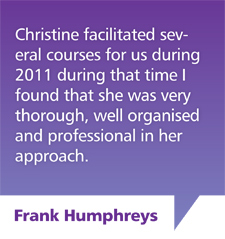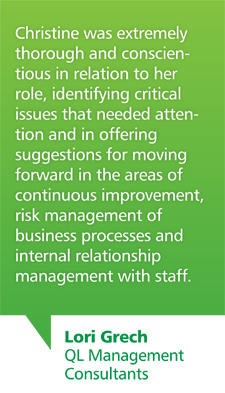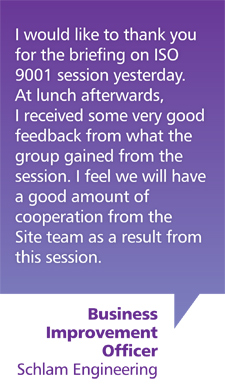Planning, Preparing & Conducting Training Workshops
I have been running public and in-house workshops for many years and on all types of topics. One thing you can be sure of as a trainer / facilitator is you can plan and prepare, but you never know who is going to walk through the door, and whether they are committed to learning, or if they are a ‘training hostage’.
The following tips will assist staff in their planning, preparation and running training workshops.
Plan and prepare
1. Prepare learning material
When deciding to run a workshop it is important to be clear as to what the topic and objective of the training is and who are the best suited employees to attend. Individuals learn differently. For example, some may be more suited to reading and then discussing theory, or learning by Power Point presentation or film clips, or by observing and being involved in role-play and team discussions. Once the format has been agreed then the preparation can begin.
2. Material preparation
If the training is to cover a simple work task or process then a methodical approach using a work instruction or even a film clip as a training aid is how the session should be planned. However, the training maybe based on the organisation's management system, risk management, team work, auditing, how to write documents etc. This will require research into the topic on possible best practice, papers produced by industry and or professional bodies, academia, ISO, AS/NZ standards, certification bodies and the organisation’s own management expectations.
a) Does anyone have a particular learning requirement, if so, accommodate needs.
b) Handouts – attendees always appreciate something to write-on during training and have that as a ‘take-away’. A handout aids learning and can be a copy of the slides being used, copies of research papers, models, and photos etc.
c) PowerPoint presentation – death by PowerPoint is a common term used and I strongly advise that each slide has talking points or models and not filled with text. The human brain will not generally stay focused for great periods of time and even less so if they have to concentrate on a slide full of text, in fact when preparing any training material the use of ‘white space’ will not only aid the look of the training material but will assist concentration.
d) Test and verify – when the training material has been developed and before printing it is a very good idea to get an independent person or person/s to review the content for accuracy, spelling and grammar – the best of us can miss things when we have been too close to the development. If the training is of great importance to the organisation and going to be on a large scale it would be a good idea to test the training materials with a small group of employees who can provide you with feedback before the final roll-out.
3. Send invitations to attend the training
The training will either be run in-house or an external venue will be organised and no matter which is selected the topic of the training, the facilitator, date, time, and location of the training needs to be included in the invitation. Attendees also generally like to know what they have to bring and if the trainer has attached reading matter or other pre-course or post-course work advice this should be explained. If providing catering don’t forget to ask if anyone has any special dietary requirements.
4. Things to consider when presenting
a) Meet and Greet – depending on the type of workshop have music playing as attendees start arriving is an option; PowerPoint presentation up; posters pinned on the walls; fun stress toys on the tables; workshop material laid out and attendees signed-off as they arrive. Always remember to greet with a smile and a handshake.
b) Dress for the occasion – Consider the location where the training is going to be held. For example, is it a work-site? Room at head office? Etc. No need to dress to impress but dress for the environment and the activities to be undertaken during the training, also remember you are representing an organisation.
c) Body language – be comfortable with the way you communicate using body language. This includes the use of hands, facial expressions, oral communication, and tone of voice, how your voice is projected and how you physically stand and move around during the workshop. Practise in front of a mirror until you feel comfortable with what you see.
d) Handling difficult attendees – on the very odd occasion we as trainers end up with someone in the group, for whatever reason, who does not want to be there. Tell-tale signs can be displayed by physical body language, negative comments and interruptions. A trainer cannot let this behaviour disrupt the rest of the group so some options are:
- Try and engage by responding to the comments in a positive way (giving them recognition)
- Using your body to exclude the individual from general conversation (no eye contact can subtly have an impact on the individual)
- During a break, and not in front of others, have a word with the individual to find out what the issue is and if there is anything you can do to assist.
e) Time management - a good idea is to put start and end times and breaks up on a board and as much as is possible keep to these. However, sometimes conversations start and the trainer / facilitator may decide to continue even though this puts the training program timing out; this needs to get agreement by the whole group. Also note - at times there may be present a rather talkative individual who will try and take over / talk over the conversation and it is the job of the trainer / facilitator to monitor and professionally manage this.
Tips
1. It is up to the person running the workshop to be very clear during the planning phase that they understand what the ‘client’ wants from the training, that is, what are the take-aways and learning objectives. If time is not spent on this the ramifications could be the trainer is never used again and seen as unprofessional, staff very negative about the quality of any future training and management may decide not to invest in anything other than ‘mandatory’ training requirements.
2. That an organisation knows its legal & ethical obligations.
3. A well planned approach for staff development including:
- Training calendar
- Skills / competency matrix
- Job / position descriptions
- Performance reviews
4. Variety in the style of learning opportunities offered to staff. For example:
- Tutor led training
- Hands-on experience
- Buddy-up
- Mentoring
- Coaching
- Distance learning
For any further information on contracting in an internal auditor to conduct your audits or auditor training please refer to more Audit Tips.










